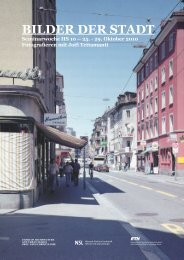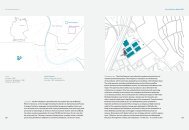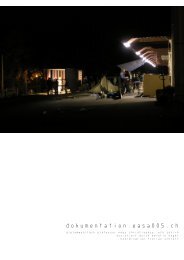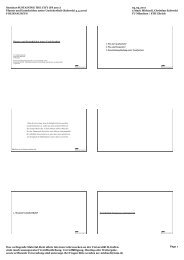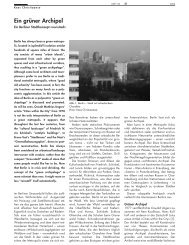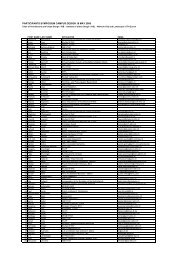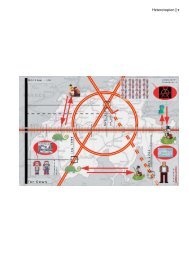Neue Urbanität in alten Häfen
Neue Urbanität in alten Häfen
Neue Urbanität in alten Häfen
Sie wollen auch ein ePaper? Erhöhen Sie die Reichweite Ihrer Titel.
YUMPU macht aus Druck-PDFs automatisch weboptimierte ePaper, die Google liebt.
<strong>Neue</strong> <strong>Urbanität</strong> <strong>in</strong> <strong>alten</strong> <strong>Häfen</strong><br />
New urbanism <strong>in</strong> former harbours<br />
»Überfluß und schöner Sche<strong>in</strong>« ist der Titel e<strong>in</strong>es klugen Buches von<br />
Simon Schama, <strong>in</strong> dem er die holländische Kultur und ihre Beziehung zum<br />
Wasser beschreibt. Er vergleicht dar<strong>in</strong> die Holländer mit dem Volk von<br />
Israel, das sich nicht nur e<strong>in</strong>mal, sondern ständig mit der S<strong>in</strong>tflut ause<strong>in</strong>andersetzen<br />
muss. Wenn man <strong>in</strong> Holland bestraft wurde, wurde man <strong>in</strong><br />
e<strong>in</strong>en Keller e<strong>in</strong>gesperrt, <strong>in</strong> den ständig Wasser floss. Der Bestrafte konnte<br />
sich nur vor dem Ertr<strong>in</strong>ken retten, <strong>in</strong>dem er ständig e<strong>in</strong>e Pumpe bediente.<br />
Tatsächlich gelang es erst nach der Flut im Jahr 1953, bei der viele Menschen<br />
ertranken, das Wasser von e<strong>in</strong>em Fe<strong>in</strong>d <strong>in</strong> e<strong>in</strong>en Freund zu verwandeln:<br />
Der Bau der Deltawerke schottete die Inseln <strong>in</strong> Seeland vom Meer ab<br />
und es entstand e<strong>in</strong> riesiges Seen- und Lagunengebiet. Parallel zum Wirtschaftswunder<br />
entwickelte sich dort e<strong>in</strong>e Freizeitkultur.<br />
In den Jahrzehnten danach gab es immer mutigere Vorschläge, das Land<br />
mit Projekten am Wasser <strong>in</strong> e<strong>in</strong>e Basis für die ewige Erholungsgesellschaft<br />
zu verwandeln. Diese Projekte planen entweder riesige Landgew<strong>in</strong>nungen,<br />
die e<strong>in</strong>en neuen Dünenrand schaffen wie etwa der Plan Waterman, oder<br />
neu geflutete Wiesen <strong>in</strong> schrumpfenden Agrargebieten oder neue Wohngebiete<br />
am Wasser an ehemaligen Hafenbecken. Die unerschöpfliche Mög-<br />
Kees Christiaanse lichkeit, neue »Urlandschaften« zu erzeugen, zeigt sich am besten an den<br />
Oostvaardersplassen <strong>in</strong> den Flevopoldern. Durch Probleme bei der Entwässerung<br />
entstand e<strong>in</strong>e zufällige Landschaft, die sich <strong>in</strong>nerhalb von 25<br />
Jahren zu e<strong>in</strong>em der wichtigsten Naturgebiete Europas entwickelte. Neben<br />
vielen Vogelarten, die vorher längst aus Holland verschwunden waren, leben<br />
hier Auerochsen und wilde Pferde.<br />
Die Debatte über Echtheit und Künstlichkeit im Städtebau ist deswegen<br />
<strong>in</strong> Holland <strong>in</strong> gewissem S<strong>in</strong>ne irrelevant. Die Notwendigkeit des geme<strong>in</strong>samen<br />
Kampfs gegen das Wasser, die frühe Vertreibung des Feudalismus<br />
und die Möglichkeit für arme Leute, durch Konzessionen e<strong>in</strong> eigenes<br />
Grundstück trockenzulegen, führte zu e<strong>in</strong>er<br />
In Hafengebieten entstehen vielfarbige Archi-<br />
sachlichen und auf Konsens e<strong>in</strong>gestellten Gesellpel-Städte.<br />
Radikaler Nutzungsmix gilt als schaftsstruktur. In der Raumordnung zeigt sich<br />
das <strong>in</strong> e<strong>in</strong>er paradoxen Komb<strong>in</strong>ation e<strong>in</strong>er ex-<br />
Modell für die gesamte Stadt.<br />
trem demokratischen und dezentralisierten Ent-<br />
Colourful archipelago districts are appear<strong>in</strong>g <strong>in</strong> scheidungsstruktur mit e<strong>in</strong>er extrem zentralistischen<br />
Raumordnungspolitik. Die Machbarkeit<br />
harbour areas. Radically mixed uses provide an<br />
der Landschaft und die Konsensgesellschaft wan-<br />
example for the whole city.<br />
delten die Niederlande zu e<strong>in</strong>er Kulturland-<br />
6<br />
The Embarrassment of Riches is the title of the<br />
learned book by Simon Schama <strong>in</strong> which he<br />
describes Dutch culture and its relationship to<br />
water. He compares the Dutch to the people of<br />
Israel. They had to cope with the Flood constantly<br />
<strong>in</strong>stead of only once. To punish people<br />
<strong>in</strong> Holland you locked them up <strong>in</strong> a cellar<br />
steadily fill<strong>in</strong>g up with water. They could only<br />
save themselves from drown<strong>in</strong>g by ceaselessly<br />
work<strong>in</strong>g the pump.<br />
In fact it was only after the flood <strong>in</strong> 1953,<br />
when many people were drowned, that the<br />
Dutch succeeded <strong>in</strong> turn<strong>in</strong>g water from an enemy<br />
<strong>in</strong>to a friend by build<strong>in</strong>g the Delta works.<br />
This watertight barrier protects the islands <strong>in</strong><br />
Zeeland from the sea and creates a vast region of<br />
lakes and lagoons. In parallel to the economic<br />
miracle, a culture of leisure developed <strong>in</strong> the area.<br />
Increas<strong>in</strong>gly dar<strong>in</strong>g proposals were then made<br />
for waterside projects to transform the land <strong>in</strong>to<br />
the home of the eternal recreation society. These<br />
projects propose huge land reclamations that create<br />
a new boundary of dunes (as did the Waterman<br />
plan), or re-flooded meadows <strong>in</strong> shr<strong>in</strong>k<strong>in</strong>g<br />
agricultural areas, or new waterside residential<br />
developments on former harbour bas<strong>in</strong>s.<br />
The <strong>in</strong>exhaustible potential for generat<strong>in</strong>g<br />
new “primeval landscapes” shows best <strong>in</strong> the<br />
Oostvaardersplassen <strong>in</strong> the Flevo polders. Problems<br />
with dra<strong>in</strong>age created a haphazard landscape.<br />
In 25 years it developed <strong>in</strong>to one of the<br />
most important nature reserves <strong>in</strong> Europe. Besides<br />
many species of birds that had long disappeared<br />
from Holland, it is the home of aurochs<br />
and wild horses.<br />
In a certa<strong>in</strong> sense the debate on genu<strong>in</strong>eness<br />
and artificiality <strong>in</strong> urban architecture <strong>in</strong> Holland
is therefore irrelevant. The need for jo<strong>in</strong>t action<br />
<strong>in</strong> the battle aga<strong>in</strong>st the water, the early banishment<br />
of feudalism, and the opportunity for poor<br />
people to reclaim land of their own through concessions<br />
led to a social structure with an objective<br />
and consensus-based approach. In zon<strong>in</strong>g issues,<br />
this is reflected <strong>in</strong> the paradoxical comb<strong>in</strong>ation of<br />
an extremely democratic and decentralised decision-mak<strong>in</strong>g<br />
structure with an extremely cen-<br />
schaft, <strong>in</strong> der tiefgehende E<strong>in</strong>griffe mit relativ wenig Bürokratie und<br />
Widerstand schnell realisiert werden. Das erklärt auch den verhältnismäßig<br />
emotionslosen Umgang mit Modernisierungsprozessen im Städtebau.<br />
Rotterdam entwickelt sich so schnell, dass man nach e<strong>in</strong>er Abwesenheit<br />
von drei Jahren bestimmte Stellen nicht mehr wiedererkennt. Die Stadt lag<br />
ursprünglich an der Nordseite der Nieuwe Maas und hat sich erst Ende des<br />
19. Jahrhunderts am anderen Ufer erweitert. Waren die wichtigsten<br />
Hafenbecken an den beiden Ufern bis um 1940 eng mit der Stadt verknüpft,<br />
so wuchs der Hafen seit 1945 auf e<strong>in</strong>e Länge von 45 Kilometer bis<br />
7<br />
In Noorderplassen West schlug<br />
KCAP e<strong>in</strong> neues Wohngebiet <strong>in</strong><br />
e<strong>in</strong>er Wasser- und Waldlandschaft<br />
vor, e<strong>in</strong>e 250 Meter<br />
breite bebaute Achse zwischen<br />
der Stadt Almere und dem<br />
Markermeer. Die unregelmäßigen<br />
Bebauungsgrenzen erlauben<br />
e<strong>in</strong>e enge Verzahnung mit<br />
Wald und Wasser.<br />
In Noorderplassen West, KCAP<br />
proposed a new residential<br />
district <strong>in</strong> a landscape of water<br />
and woods, a 250-metre-wide<br />
built-up axis between the city<br />
of Almere and the Marker Sea.<br />
The irregular edges of the architecture<br />
allow it to dovetail<br />
with the woods and the water.
nach Hoek van Holland. In den letzten Jahren vergrößert er sich mit rund<br />
500 Hektar pro Jahrzehnt <strong>in</strong> die Nordsee und nimmt e<strong>in</strong> Vielfaches der<br />
Stadtoberfläche e<strong>in</strong>. Die Ausweitung des Hafens hat die kle<strong>in</strong>eren Hafenbecken,<br />
mit denen die Stadt bis 1940 eng verzahnt war, teilweise obsolet gemacht.<br />
Durch die Umnutzung der großflächigen <strong>in</strong>nenstadtnahen Areale<br />
wurde aus der Hafenstadt e<strong>in</strong>e Dienstleistungs- und Wohnstadt mit »venezianischen«<br />
Ambitionen. Nur wenigen war bewusst, dass die Entwicklung<br />
des Wohnens <strong>in</strong> ehemaligen Hafengebieten, die Ende der siebziger Jahre<br />
e<strong>in</strong>setzte, schon 15 Jahre später zum Schlüssel der Revitalisierung von Innenstädten<br />
werden und sogar die Rettung e<strong>in</strong>er bestimmten Form von<br />
<strong>Urbanität</strong> bedeuten würde. Die ersten Hafenareale bebaute man überwiegend<br />
mit traditionellen Wohnformen, bee<strong>in</strong>flusst von Bewohner-Mitsprache-Prozessen.<br />
Die politische Tagesordnung stand im Zeichen des sozialen<br />
Klimas der siebziger Jahre: Wohnungsnot sollte mit sozialem Wohnungsbau<br />
gelöst werden, f<strong>in</strong>anziert von Geme<strong>in</strong>den, Wohnungsbaugenossenschaften<br />
und Subventionen für Stadterneuerung.<br />
E<strong>in</strong> gutes Beispiel ist der IJ-Ple<strong>in</strong> <strong>in</strong> Amsterdam-Nord, 1980 von OMA<br />
entworfen. Auf e<strong>in</strong>em Gebiet, das heute als e<strong>in</strong> absoluter Spitzenstandort<br />
gilt, wurden 1 400 Sozialwohnungen realisiert. Am Anfang wollte OMA<br />
das Gebiet mit Hochhäusern verdichten und e<strong>in</strong>e Skyl<strong>in</strong>e entlang des Wassers<br />
schaffen. Das scheiterte am Veto der Anwohner, die das Programm<br />
weitgehend bee<strong>in</strong>flussten: Die Hälfte der Wohnungen bestand aus E<strong>in</strong>familien-Reihenhäusern.<br />
Diese, <strong>in</strong> der Tradition der Gartenstadt entworfene<br />
suburbane Work<strong>in</strong>g-Class-Idylle auf e<strong>in</strong>em strategischen Wasserfrontstandort<br />
gegenüber dem Hauptbahnhof, e<strong>in</strong>e naive Reflektion von Kurt<br />
Tucholskys »vorne die Friedrichstraße, h<strong>in</strong>ten die Ostsee…«, war e<strong>in</strong> unbewusster<br />
Vorläufer von späteren Konzepten für hochverdichtetes und erdgebundenes<br />
Wohnen, wie etwa Borneo-Sporenburg <strong>in</strong> Amsterdam und Müllerpier<br />
<strong>in</strong> Rotterdam. Gleichzeitig mit dem IJ-Ple<strong>in</strong> <strong>in</strong> Amsterdam bekam<br />
OMA anlässlich der Publikation von »Delirious New York« den Auftrag für<br />
e<strong>in</strong>en Hochhaus-Komplex am Wasser <strong>in</strong> Rotterdam. Der Entwurf war e<strong>in</strong><br />
hybrides, 99 Meter hohes Gebäude aus Türmen, die ane<strong>in</strong>ander gereiht<br />
e<strong>in</strong>e Scheibe ergaben. Der Maßstabssprung <strong>in</strong> Form und Höhe verweist auf<br />
den traditionellen Kontrast zwischen Getreidesilos, Dampfschiffen und<br />
Speichern entlang der Kais und der niedrigen Bebauung der dah<strong>in</strong>ter gelegenen<br />
Hafenviertel. OMAs Gebäude, das se<strong>in</strong>er Zeit weit voraus war und<br />
als erstes <strong>in</strong> Holland völlig aus frei e<strong>in</strong>teilbaren Lofts bestand, wurde nicht<br />
8<br />
tralised zon<strong>in</strong>g policy. The workability of the<br />
landscape and the consensus society have<br />
changed the Netherlands <strong>in</strong>to a cultural landscape<br />
where far-reach<strong>in</strong>g <strong>in</strong>terventions were realised<br />
quickly with relatively little bureaucracy<br />
and resistance. This also expla<strong>in</strong>s the rather unemotional<br />
handl<strong>in</strong>g of modernisation processes<br />
<strong>in</strong> urban design.<br />
Rotterdam is develop<strong>in</strong>g so rapidly that if you<br />
had been away for three years you could not<br />
recognise certa<strong>in</strong> places. The city was orig<strong>in</strong>ally<br />
located on the north bank of the Nieuwe Maas<br />
and only spread to the opposite bank at the end<br />
of the 19th century. While the major harbour<br />
bas<strong>in</strong>s on both banks were closely l<strong>in</strong>ked to the<br />
city until around 1940, the port expanded to a<br />
length of 45 kilometres all the way to Hoek van<br />
Holland from 1945 on. In the last few years it<br />
grew towards the North Sea at a rate of about 500<br />
hectares per decade, tak<strong>in</strong>g up a much larger area<br />
than the city. The expansion of the port made the<br />
smaller bas<strong>in</strong>s dat<strong>in</strong>g from before 1940 partly obsolete.<br />
The conversion of these large <strong>in</strong>ner city areas<br />
turned the harbour district <strong>in</strong>to a service and<br />
residential district with “Venetian” aspirations.<br />
Only few people were aware that the development<br />
of hous<strong>in</strong>g <strong>in</strong> former harbours start<strong>in</strong>g at<br />
the end of the seventies would become the key to<br />
the revitalisation of <strong>in</strong>ner cities and even represent<br />
the salvag<strong>in</strong>g of a certa<strong>in</strong> form of urbanism<br />
only 15 years later.<br />
The first harbour districts were built up with<br />
ma<strong>in</strong>ly traditional forms of hous<strong>in</strong>g, reflect<strong>in</strong>g<br />
the say that residents had <strong>in</strong> the plann<strong>in</strong>g process.<br />
The political order of the day was marked by the<br />
social climate of the seventies: the hous<strong>in</strong>g shortage<br />
was to be solved by build<strong>in</strong>g subsidised hous-
<strong>in</strong>g funded by municipalities, cooperative build<strong>in</strong>g<br />
societies and urban renewal subsidies.<br />
A good example is the IJ-Ple<strong>in</strong> <strong>in</strong> Amsterdam<br />
North designed by OMA <strong>in</strong> 1980. In what is now<br />
an absolutely top location, they realised 1,400<br />
subsidised residential units. At first OMA wanted<br />
to make the area very dense, with high-rises<br />
creat<strong>in</strong>g a skyl<strong>in</strong>e along the water. This failed because<br />
it was vetoed by the neighbour<strong>in</strong>g residents,<br />
who had a considerable <strong>in</strong>fluence on the<br />
program. Half of the homes ended up be<strong>in</strong>g s<strong>in</strong>gle-family<br />
row houses. This suburban work<strong>in</strong>gclass<br />
idyll <strong>in</strong> the garden-city tradition on a strategic<br />
waterfront site opposite the central station, a<br />
naive reflection of Kurt Tucholsky’s “Friedrichstrasse<br />
at the front door, the Baltic Sea <strong>in</strong> the<br />
backyard…”, was an unconscious precursor of<br />
later concepts for extremely dense and earthbound<br />
hous<strong>in</strong>g such as Borneo-Sporenburg <strong>in</strong><br />
Amsterdam and the Müllerpier <strong>in</strong> Rotterdam.<br />
At the same time as the IJ-Ple<strong>in</strong> <strong>in</strong> Amsterdam<br />
and on the occasion of the publication of<br />
Delirious New York, OMA received the commission<br />
for a high-rise complex by the water <strong>in</strong><br />
Rotterdam. The design was a hybrid 99-metrehigh<br />
structure of towers l<strong>in</strong>ed up <strong>in</strong> a row to look<br />
like a s<strong>in</strong>gle slab. Its scaled-up form and height<br />
referred to the traditional contrast between gra<strong>in</strong><br />
elevators, steamships and warehouses along the<br />
quays and the low structures of the harbour<br />
quarter beh<strong>in</strong>d them. OMA’s build<strong>in</strong>g, which<br />
was far ahead of its time and the first <strong>in</strong> Holland<br />
to consist of lofts that could be subdivided at<br />
will, was not realised. Today, 20 years later, the<br />
design returns <strong>in</strong> re<strong>in</strong>carnated form as The<br />
Rotterdam, a build<strong>in</strong>g on the former wharf of<br />
the legendary passenger l<strong>in</strong>er “Rotterdam”.<br />
realisiert. Heute, 20 Jahre später, kehrt der Entwurf <strong>in</strong> re<strong>in</strong>karnierter Form<br />
zurück, als Gebäude »The Rotterdam« beim ehemaligen Anlageplatz des legendären<br />
Passagiersschiffes »Rotterdam«.<br />
In »Die Stadt als Loft« <strong>in</strong> Topos 38 schrieb ich, dass wir den Begriff<br />
<strong>Urbanität</strong> als den Moment def<strong>in</strong>ieren können, <strong>in</strong> dem neue Netzwerke aus<br />
der Interaktion von <strong>alten</strong> entstehen können. Dies stimmt übere<strong>in</strong> mit den<br />
Gedanken von Henri Levebre <strong>in</strong> den siebziger Jahren. Er schrieb, dass großstädtische<br />
Qualität aus Netzwerken, Grenzen und Differenzen entstehe<br />
und dass die gegenseitige Reibung dieser Differenzen sich <strong>in</strong> Erkennung,<br />
Anerkennung, Befruchtung und produktiver Umsetzung ausdrücke.<br />
In zentralen ungenutzten Hafengebieten, die von neuen unterschiedlichen<br />
Aktivitäten kolonisiert werden, entstehen derartige Differenzen als<br />
Nährboden für kulturelle Erneuerung. E<strong>in</strong> besonders produktives Klima<br />
entsteht beim Aufe<strong>in</strong>andertreffen unterschiedlich engagierter Gruppen,<br />
wie etwa Hausbesetzern, Künstlern, Yuppies und »urbanen Älteren«. In den<br />
offiziellen Stadtzentren nimmt diese Reibung der Differenzen durch Kommerzialisierung<br />
ständig ab. Hafengebiete können so die Kultrolle übernehmen,<br />
die Viertel wie Greenwich Village <strong>in</strong> den 70er Jahren spielten.<br />
Die KNSM-Insel <strong>in</strong> Amsterdam, entworfen vom Architekten Jo Coenen,<br />
verdankt ihre Kraft der Mischung von alter und neuer Bebauung<br />
Niedrige Wohnbebauung prägt<br />
den IJ-Ple<strong>in</strong> <strong>in</strong> Rotterdam. Ursprünglich<br />
schlug OMA e<strong>in</strong>e<br />
Skyl<strong>in</strong>e entlang des Wassers<br />
und gemischte Nutzung für<br />
den prom<strong>in</strong>enten Standort vor.<br />
Dies scheiterte jedoch am Veto<br />
der Anwohner.<br />
Low-rise hous<strong>in</strong>g characterises<br />
the IJ-Ple<strong>in</strong> <strong>in</strong> Rotterdam. OMA<br />
had orig<strong>in</strong>ally proposed a waterfront<br />
skyl<strong>in</strong>e and mixed uses<br />
for the prom<strong>in</strong>ent site. This<br />
failed, however, because local<br />
residents vetoed the proposal.<br />
9
sowie dem Kontrast zwischen den Nutzern der <strong>alten</strong> Gebäude wie Künstlern<br />
und der Clubszene sowie den neuen Bewohnern. Die dadurch entstandene<br />
Atmosphäre zog e<strong>in</strong>e reiche Palette neuer Nutzer an und bee<strong>in</strong>flusste<br />
auch die Investoren.<br />
Noch mehr Vielfalt entsteht mittlerweile entlang der Oostelijke<br />
Handelskade <strong>in</strong> Amsterdam. Lofts, Gewerberäume, Clubs und E<strong>in</strong>kaufszentren<br />
f<strong>in</strong>den Platz <strong>in</strong> umgebauten, denkmalgeschützten Speichern. Dazwischen<br />
und darüber entsteht neue Bebauung: e<strong>in</strong> Cruise-Term<strong>in</strong>al mit<br />
Hotels, e<strong>in</strong> Theater, Sozialwohnungsbau, exklusive Büros, Lofts und<br />
teure Penthouses. Die »offiziellen« Investoren haben unter E<strong>in</strong>fluss der<br />
»offiziösen« Benutzung durch die Kunst- und Clubszene ihre Marktstrategie<br />
auf e<strong>in</strong>e Mischung aus »low budget high culture« und »high budget low<br />
culture«-Programmen ausgerichtet. Trotz dieser Strategie bleibt auch die<br />
Oostelijke Handelskade e<strong>in</strong>e überwiegend »offizielle« Entwicklung, <strong>in</strong> der<br />
die »normale« kommerzielle Immobilie dom<strong>in</strong>iert.<br />
Dass diese Entwicklungen auch neue Formen von Unternehmerschaft<br />
hervorbr<strong>in</strong>gen, zeigt Urban Splash <strong>in</strong> Manchester oder Hotel New York <strong>in</strong><br />
Rotterdam. Das Unternehmen Urban Splash gründeten teils junge Architekten,<br />
die – arbeitslos während der Thatcher-Zeit – e<strong>in</strong>en Club <strong>in</strong> e<strong>in</strong>em<br />
<strong>alten</strong> Speicher eröffneten. Vorher hatte die Gruppe bereits e<strong>in</strong> Schallplatten-Label<br />
und e<strong>in</strong> Restaurant mit Delishop gegründet. Den Speicher kauften<br />
sie für e<strong>in</strong>en symbolischen Betrag der Stadt ab und bauten ihn <strong>in</strong> e<strong>in</strong><br />
Loft-Gebäude um. Mit dem verdienten Geld starteten sie neue Projekte.<br />
Das daraus entstandene Unternehmen beschäftigt sich mit e<strong>in</strong>em reichen<br />
Aktivitäten-Cocktail zwischen Pop und Real Estate, der e<strong>in</strong>e ganze Re-<br />
Urbanisierungskette <strong>in</strong> Manchester und Liverpool entfesselte. E<strong>in</strong>er der<br />
Urväter von Urban Splash, Tom Bloxham, avancierte mittlerweile zum vielgefragten<br />
Berater zahlloser Stadterneuerungs- und Kultur<strong>in</strong>itiativen.<br />
Der Architekt Jo Coenen ergänzte<br />
den Bestand auf der<br />
KNSM-Insel, Amsterdam, mit<br />
neuer Bebauung. Dies ergab<br />
e<strong>in</strong>e <strong>in</strong>teressante Mischung<br />
von Bauten sowie Nutzungen<br />
und zeugt von e<strong>in</strong>em neuen<br />
Verständnis von Mischung,<br />
Vielfalt sowie <strong>Urbanität</strong> <strong>in</strong><br />
verlassenen Hafengebieten.<br />
10<br />
The architect Jo Coenen added<br />
new build<strong>in</strong>gs to the exist<strong>in</strong>g<br />
structures on KNSM Island <strong>in</strong><br />
Amsterdam. The result is an<br />
<strong>in</strong>terest<strong>in</strong>g mixture of build<strong>in</strong>gs<br />
and uses. It testifies to<br />
a new understand<strong>in</strong>g of mixtures,<br />
diversity and urbanism<br />
<strong>in</strong> the process of regenerat<strong>in</strong>g<br />
abandoned harbour districts.<br />
In “The city as loft” <strong>in</strong> Topos 38 I wrote that<br />
we might def<strong>in</strong>e the concept of urbanism as the<br />
moment new networks can evolve from the <strong>in</strong>teraction<br />
of the old. This agrees with ideas put<br />
forward by Henri Levebre <strong>in</strong> the seventies. He<br />
wrote that urban quality comes about through<br />
networks, boundaries and differences, and that<br />
the mutual friction of these differences is expressed<br />
<strong>in</strong> recognition, acceptance, fertilisation<br />
and productive application.<br />
Aris<strong>in</strong>g <strong>in</strong> centrally located, abandoned harbours<br />
colonised by diverse new activities, such<br />
differences are fertile soil for cultural renewal.<br />
The encounter between groups with different<br />
commitments, such as squatters, artists, yuppies<br />
and “urban elders”, generates an especially productive<br />
climate. In official city centres this friction<br />
between differences is dim<strong>in</strong>ish<strong>in</strong>g steadily<br />
because of <strong>in</strong>creas<strong>in</strong>g commercialisation. Harbour<br />
districts can take on cult roles such as that<br />
of Greenwich Village <strong>in</strong> the 70s.<br />
The KNSM Islands <strong>in</strong> Amsterdam designed<br />
by Jo Coenen owe their power to the mixture of<br />
old and new construction as well as to the contrast<br />
between users of the old build<strong>in</strong>gs, such as<br />
artists and the club scene, and the new residents.<br />
The result<strong>in</strong>g atmosphere attracted a wide range<br />
of new users. It also <strong>in</strong>fluenced the <strong>in</strong>vestors.<br />
By now there is even more variety develop<strong>in</strong>g<br />
along the Oostelijke Handelskade <strong>in</strong> Amsterdam.<br />
Lofts, commercial spaces, clubs and shopp<strong>in</strong>g<br />
centres are accommodated <strong>in</strong> converted listed<br />
warehouses. New structures are appear<strong>in</strong>g <strong>in</strong> between<br />
and on top: a cruise term<strong>in</strong>al with hotels,<br />
a theatre, subsidised hous<strong>in</strong>g, exclusive offices,<br />
lofts and expensive penthouses. Influenced by the<br />
“semi-official” uses of the arts and club scene, the
“official” <strong>in</strong>vestors have based their market strategy<br />
on a mixture of “low budget high culture”<br />
and “high budget low culture”. Despite this strategy,<br />
even the Oostelijke Handelskade rema<strong>in</strong>s a<br />
largely “official” development <strong>in</strong> which “normal”<br />
commercial real estate predom<strong>in</strong>ates.<br />
The fact that these developments also produce<br />
new forms of entrepreneurship is demonstrated<br />
by Urban Splash <strong>in</strong> Manchester and Hotel<br />
New York <strong>in</strong> Rotterdam. Urban Splash was<br />
founded <strong>in</strong> part by young architects, unemployed<br />
<strong>in</strong> the Thatcher era, who opened a club <strong>in</strong> an old<br />
warehouse. The group had already launched a<br />
record label and a restaurant with a delicatessen.<br />
They bought the warehouse from the city for a<br />
Vor 25 Jahren verkaufte Daan van der Have (»vom Hafen«) noch gebrauchte<br />
Schuhe auf dem Flohmarkt. Nachdem er e<strong>in</strong> Jazz-Café eröffnet<br />
hatte, folgten e<strong>in</strong>e Punk-Disco, e<strong>in</strong>e Frauenkneipe und e<strong>in</strong> Literaten-Café.<br />
Er betrieb e<strong>in</strong> italienisches, danach e<strong>in</strong> Gourmet-Restaurant und revitalisierte<br />
mehrere alte Häuser. Zum Schluss verkaufte er alles und eröffnete das<br />
Hotel New York im ehemaligen Hauptgebäude der Holland Amerika L<strong>in</strong>ie.<br />
Dieses Hotel, bestes Beispiel für e<strong>in</strong>e erfolgreiche Nachnutzung, verdankte<br />
se<strong>in</strong>en Erfolg se<strong>in</strong>er e<strong>in</strong>samen Lage mitten im ungenutzten Hafen und erfüllte<br />
gleichzeitig e<strong>in</strong>e Pionierrolle bei der Entwicklung von Kop van Zuid.<br />
Der Unterschied zwischen dieser Art von Unternehmen und den demokratischen<br />
Mitsprache-Projekten der siebziger Jahre, aus denen sie sich entwickelt<br />
haben, liegt <strong>in</strong> der Ungeniertheit, Risiken e<strong>in</strong>zugehen, <strong>in</strong> der Begabung,<br />
potenzielle Nachnutzungsmöglichkeiten zu erkennen und <strong>in</strong> der<br />
Fähigkeit, komplexe, oft unorthodoxe Kommunikationsprozesse zwischen<br />
den Beteiligten zu managen (»Stakeholder-Management«).<br />
Mit dem Entwurf für das Gebäude<br />
»The Rotterdam« (l<strong>in</strong>ks)<br />
er<strong>in</strong>nert OMA an e<strong>in</strong> früheres,<br />
nie realisiertes Projekt – e<strong>in</strong>en<br />
Hochhauskomplex direkt an<br />
der Maas (rechts). Der Maßstabssprung<br />
verweist auf den<br />
traditionellen Kontrast zwischen<br />
Silos, Dampfschiffen,<br />
Speichern und der niedrigen<br />
Bebauung der Hafenviertel.<br />
In their design for “The Rotterdam”<br />
build<strong>in</strong>g (left), OMA recalls<br />
an earlier, never realised,<br />
project: a high-rise complex<br />
right on the River Maas<br />
(right). The jump <strong>in</strong> scale<br />
refers to the traditional contrast<br />
between gra<strong>in</strong> elevators,<br />
steamships, warehouses and<br />
the low-rise build<strong>in</strong>gs of the<br />
harbour district.<br />
11
Gerade diese Initiatoren, die sich im Planungsprozess von <strong>in</strong>formell<br />
Engagierten zu offiziell Beteiligten entwickelt haben, geben bei fast allen<br />
beispielhaften Nachnutzungs- oder temporären Nutzungsprojekten den<br />
Ausschlag für den Erfolg beziehungsweise sorgen für den maßgeblichen<br />
Entwicklungsschub. Entsprechend begleitet diesen Entwicklungsprozess<br />
auch immer e<strong>in</strong>e Gentrifizierungs-Welle.<br />
E<strong>in</strong> illustrativer Vergleich ist jener zwischen den Beteiligungsverfahren<br />
der 70er Jahre, der Sachlichkeit der 90er Jahre, und dem Stakeholder-<br />
Management von heute: In den 70er Jahren dom<strong>in</strong>ierten die Hausbesetzer,<br />
Anwohner und Bezirkspolitiker den Entscheidungsprozess über Investoren<br />
und zentrale Politik – e<strong>in</strong>e Situation, die auf Dauer nicht haltbar war. In<br />
den 90er Jahren führte das zu e<strong>in</strong>er Umkehrung – Investoren und Senatoren<br />
eroberten erneut die Macht, geme<strong>in</strong>sam mit der wachsenden New-Economy.<br />
Das Stakeholder-Management, das wir heute anwenden, platziert<br />
alle Teilnehmer – Kapitalisten und Aktivisten – <strong>in</strong> e<strong>in</strong>em ganzheitlichen<br />
Interaktionsmodell, wobei der E<strong>in</strong>fluss jedes Stakeholders vorher im E<strong>in</strong>klang<br />
mit se<strong>in</strong>er Position festgelegt wird. Diesen Entscheidungsprozess betrachten<br />
wir als Teil des städtebaulichen Entwurfes.<br />
E<strong>in</strong> geme<strong>in</strong>samer Entwurf für<br />
die Amsterdamer Wasserfront<br />
von OMA, KCAP, West 8, UN<br />
Studio und Neutel<strong>in</strong>gs Riedijk<br />
scheiterte 1991. Wichtige Folgerung<br />
und offizielles Leitmotiv<br />
für die weitere Entwicklung<br />
ist, das Gebiet nicht harmonisch<br />
zu gest<strong>alten</strong>, sondern als<br />
e<strong>in</strong>en vielfarbigen Archipel unterschiedlicher<br />
städtebaulicher<br />
Konzepte zu sehen.<br />
A jo<strong>in</strong>t design for the Amsterdam<br />
waterfront by OMA,<br />
KCAP, West 8, UN Studio and<br />
Neutel<strong>in</strong>gs Riedijk failed <strong>in</strong><br />
1991. An important conclusion,<br />
and the official leitmotif<br />
for further development, was<br />
to design the area so as not to<br />
be harmonious but colourful,<br />
an archipelago of different urban<br />
design concepts.<br />
12<br />
token sum and converted it <strong>in</strong>to lofts. They used<br />
the money they made to start new projects. The<br />
result<strong>in</strong>g enterprise has a rich mixture of activities<br />
between pop and real estate, unleash<strong>in</strong>g a whole<br />
series of re-urbanisations <strong>in</strong> Manchester and<br />
Liverpool. One of the found<strong>in</strong>g fathers of Urban<br />
Splash, Tom Bloxham, has now advanced to be<strong>in</strong>g<br />
a consultant much <strong>in</strong> demand for countless<br />
urban renewal and cultural <strong>in</strong>itiatives.<br />
Twenty-five years ago Daan van der Have<br />
(“from the harbour”) was sell<strong>in</strong>g used shoes at the<br />
flea market. After open<strong>in</strong>g a jazz café, he followed<br />
with a punk disco, a women’s pub and a literary<br />
café. He ran an Italian restaurant, then a gourmet<br />
one, and he revitalised several old houses. He f<strong>in</strong>ally<br />
sold everyth<strong>in</strong>g and opened Hotel New<br />
York <strong>in</strong> the former head office of the Holland<br />
America L<strong>in</strong>e. This hotel, the best example of a<br />
successful conversion, owes its success to its isolated<br />
location <strong>in</strong> the midst of an unused port. It<br />
also played a pioneer<strong>in</strong>g role <strong>in</strong> the development<br />
of Kop van Zuid at the same time.<br />
The difference between this k<strong>in</strong>d of undertak<strong>in</strong>g<br />
and the democratic projects of the seventies<br />
with their community <strong>in</strong>put, from which they<br />
evolved, is <strong>in</strong> the un<strong>in</strong>hibited risk-tak<strong>in</strong>g, the talent<br />
for recognis<strong>in</strong>g potential for conversion, and<br />
the ability to manage complex, often unorthodox<br />
communication processes among the participants<br />
(“stakeholder management”). In almost all of the<br />
exemplary conversion or temporary-use projects,<br />
it is exactly this k<strong>in</strong>d of <strong>in</strong>itiator, chang<strong>in</strong>g from<br />
<strong>in</strong>formal <strong>in</strong>to official participant <strong>in</strong> the course of<br />
the plann<strong>in</strong>g process, who provides the impetus<br />
for success or sees to provid<strong>in</strong>g the decisive development<br />
push. Correspond<strong>in</strong>gly, this process is always<br />
accompanied by a wave of gentrification.
This is illustrated by compar<strong>in</strong>g the participant<br />
process of the 70s, the objectivity of the 90s,<br />
and the stakeholder management of today. In the<br />
70s squatters, residents and local politicians<br />
dom<strong>in</strong>ated over <strong>in</strong>vestors and centralised policies<br />
<strong>in</strong> the decision-mak<strong>in</strong>g process, a situation that<br />
was untenable <strong>in</strong> the long run. This led to a reversal<br />
<strong>in</strong> the 90s: <strong>in</strong>vestors and senators seized<br />
power aga<strong>in</strong>, accompanied by the grow<strong>in</strong>g New<br />
Economy. The stakeholder management we apply<br />
today places all the participants, both capitalists<br />
and activists, <strong>in</strong> a holistic <strong>in</strong>teractive model<br />
whereby the <strong>in</strong>fluence exerted by each stakeholder<br />
is predeterm<strong>in</strong>ed accord<strong>in</strong>g to the person’s position.<br />
We regard this decision-mak<strong>in</strong>g process as<br />
part of urban plann<strong>in</strong>g and design.<br />
Oostelijke Havengebied developed <strong>in</strong> the<br />
form of <strong>in</strong>dependent projects after the failure of<br />
an attempt at an overall design for the Amsterdam<br />
waterfront by OMA, KCAP, West 8, UN<br />
Studio and Neutel<strong>in</strong>gs Riedijk commissioned by<br />
the city and the ING Bank <strong>in</strong> 1991. Fortunately<br />
the most important outcome of the project,<br />
namely not to see the waterfront as an attempt at<br />
design harmony but as a varicoloured archipelago<br />
of diverse urban architectural concepts, was<br />
officially established as the leitmotiv for further<br />
development. This leitmotiv seems to be turn<strong>in</strong>g<br />
<strong>in</strong>to a generally accepted pr<strong>in</strong>ciple not only for<br />
waterfronts but also other urban areas. Obviously<br />
the unpredictability of urban developments<br />
can only be mastered with the help of the “archipelago<br />
city”, consist<strong>in</strong>g of islands with an easily<br />
recognisable urban architectural and functional<br />
character embedded <strong>in</strong> a powerful medium –<br />
such as the water <strong>in</strong> this case or the green areas<br />
<strong>in</strong> Berl<strong>in</strong>.<br />
Das Oostelijke Havengebied entwickelte sich <strong>in</strong> vone<strong>in</strong>ander unabhängigen<br />
Projekten, nachdem 1991 der Versuch e<strong>in</strong>es Gesamtentwurfs<br />
für die Amsterdamer Wasserfront von OMA, KCAP, West 8, UN Studio<br />
und Neutel<strong>in</strong>gs Riedijk im Auftrag der Stadt und der ING-Bank buchstäblich<br />
»<strong>in</strong>s Wasser gefallen« war. Glücklicherweise wurde die wichtigste<br />
Folgerung aus dem Projekt, nämlich die Wasserfront nicht als Versuch zur<br />
gestalterischen Harmonie, sondern als e<strong>in</strong>en vielfarbigen Archipel unterschiedlicher<br />
städtebaulicher Konzepte zu sehen, offiziell als Leitmotiv für<br />
die weitere Entwicklung festgelegt. Dieses Leitmotiv<br />
sche<strong>in</strong>t sich zu e<strong>in</strong>em allgeme<strong>in</strong> gültigen<br />
Pr<strong>in</strong>zip zu entwickeln, nicht nur für Wasserfronten,<br />
sondern auch für andere städtische Gebiete.<br />
Die Unvorhersagbarkeit urbaner Entwicklungen<br />
kann man offensichtlich nur beherrschen<br />
mit Hilfe der Archipel-Stadt, bestehend<br />
aus Inseln mit e<strong>in</strong>em klar erkennbaren<br />
städtebaulichen und funktionellen Charakter,<br />
e<strong>in</strong>gebettet <strong>in</strong> e<strong>in</strong> kräftiges Medium – wie hier<br />
das Wasser oder <strong>in</strong> Berl<strong>in</strong> das Grün.<br />
13<br />
Müllerpier (oben) und Lloydpier<br />
<strong>in</strong> Rotterdam be<strong>in</strong>h<strong>alten</strong><br />
e<strong>in</strong>e experimentelle Mischung<br />
von Hochhäusern und kle<strong>in</strong>maßstäblicher<br />
Bebauung.<br />
Zeitgenössische <strong>Urbanität</strong> verlangt<br />
aber nach noch radikaleren<br />
Konzepten und Komb<strong>in</strong>ationen,<br />
sowohl für die Bebauung<br />
als auch für Nutzung.<br />
Müllerpier (top) and Lloydpier<br />
<strong>in</strong> Rotterdam consist of an<br />
experimental mixture of highrises<br />
and small-scale structures.<br />
However, current urbanism<br />
calls for more radical concepts<br />
and comb<strong>in</strong>ations <strong>in</strong> both<br />
development forms and uses.



